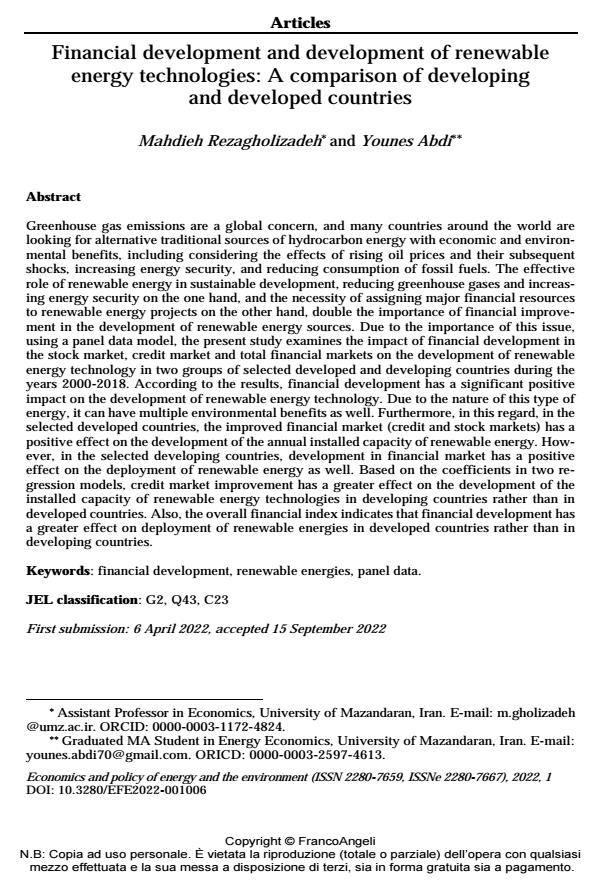Financial development and development of renewable energy technologies: A comparison of developing and developed countries
Journal title ECONOMICS AND POLICY OF ENERGY AND THE ENVIRONMENT
Author/s Mahdieh Rezagholizadeh, Younes Abdi
Publishing Year 2022 Issue 2022/1
Language English Pages 24 P. 95-118 File size 282 KB
DOI 10.3280/EFE2022-001006
DOI is like a bar code for intellectual property: to have more infomation
click here
Below, you can see the article first page
If you want to buy this article in PDF format, you can do it, following the instructions to buy download credits

FrancoAngeli is member of Publishers International Linking Association, Inc (PILA), a not-for-profit association which run the CrossRef service enabling links to and from online scholarly content.
Greenhouse gas emissions are a global concern, and many countries around the world are looking for alternative traditional sources of hydrocarbon energy with economic and environ- mental benefits, including considering the effects of rising oil prices and their subsequent shocks, increasing energy security, and reducing consumption of fossil fuels. The effective role of renewable energy in sustainable development, reducing greenhouse gases and increasing energy security on the one hand, and the necessity of assigning major financial resources to renewable energy projects on the other hand, double the importance of financial improve- ment in the development of renewable energy sources. Due to the importance of this issue, using a panel data model, the present study examines the impact of financial development in the stock market, credit market and total financial markets on the development of renewable energy technology in two groups of selected developed and developing countries during the years 2000-2018. According to the results, financial development has a significant positive impact on the development of renewable energy technology. Due to the nature of this type of energy, it can have multiple environmental benefits as well. Furthermore, in this regard, in the selected developed countries, the improved financial market (credit and stock markets) has a positive effect on the development of the annual installed capacity of renewable energy. How- ever, in the selected developing countries, development in financial market has a positive effect on the deployment of renewable energy as well. Based on the coefficients in two re- gression models, credit market improvement has a greater effect on the development of the installed capacity of renewable energy technologies in developing countries rather than in developed countries. Also, the overall financial index indicates that financial development has a greater effect on deployment of renewable energies in developed countries rather than in developing countries. JEL classification: G2, Q43, C23
Keywords: financial development, renewable energies, panel data.
Jel codes: G2, Q43, C23
- Effect of energy consumption on economic growth and sustainability: Panel evidence from PCSE and FGLS Titiksha Das, Debasis Chakraborty, in ECONOMICS AND POLICY OF ENERGY AND THE ENVIRONMENT 2/2024 pp.37
DOI: 10.3280/EFE2024-002002 - papel de las tecnologías de la información y la comunicación (TIC) en la relación entre asimetría de la información y desarrollo financiero: nuevas pruebas basadas en el modelo PSTR Mahdieh Rezagholizadeh, Majid Aghaei, Atefeh Alipour Kebria, in Revista de Métodos Cuantitativos para la Economía y la Empresa /2024 pp.1
DOI: 10.46661/rev.metodoscuant.econ.empresa.6999
Mahdieh Rezagholizadeh, Younes Abdi, Financial development and development of renewable energy technologies: A comparison of developing and developed countries in "ECONOMICS AND POLICY OF ENERGY AND THE ENVIRONMENT" 1/2022, pp 95-118, DOI: 10.3280/EFE2022-001006